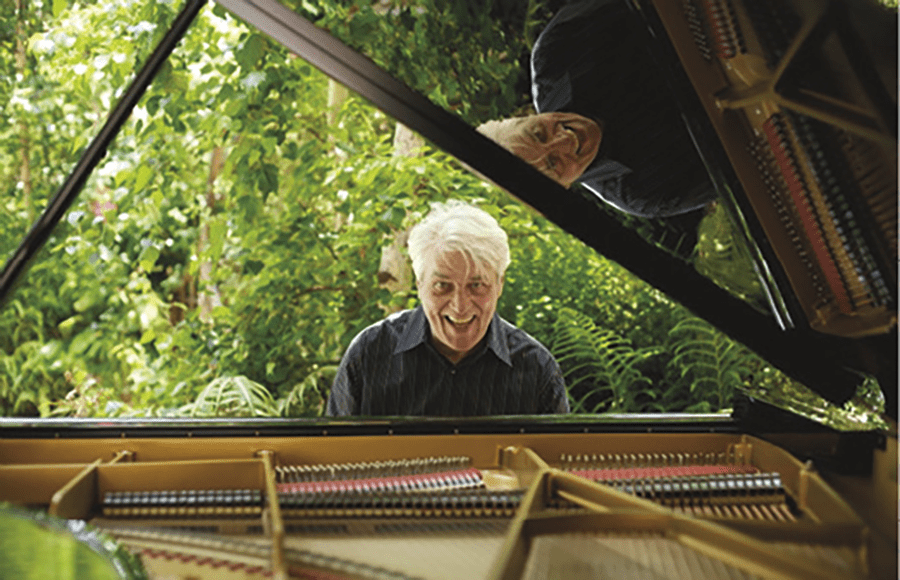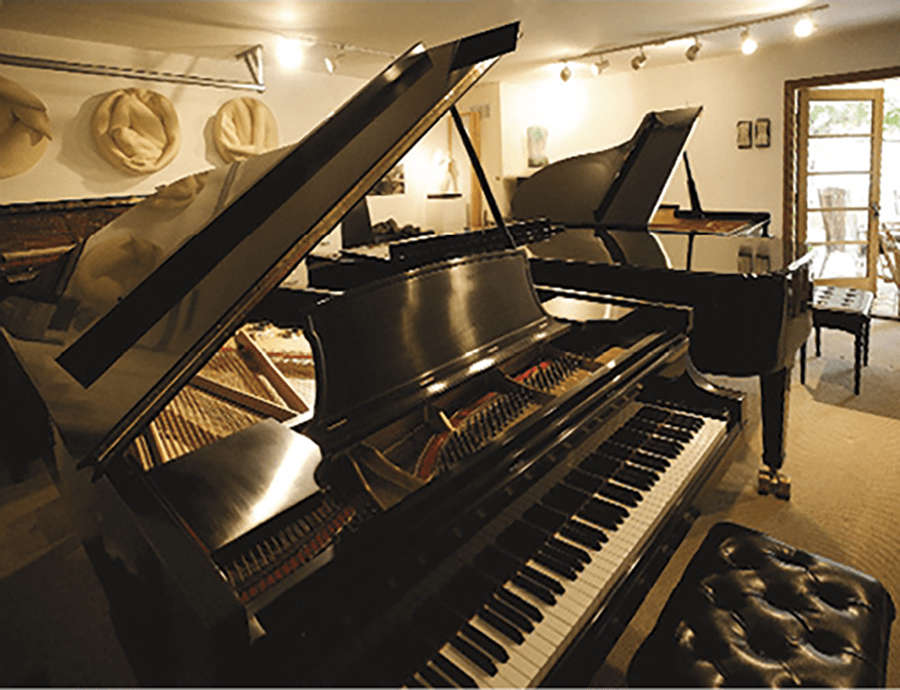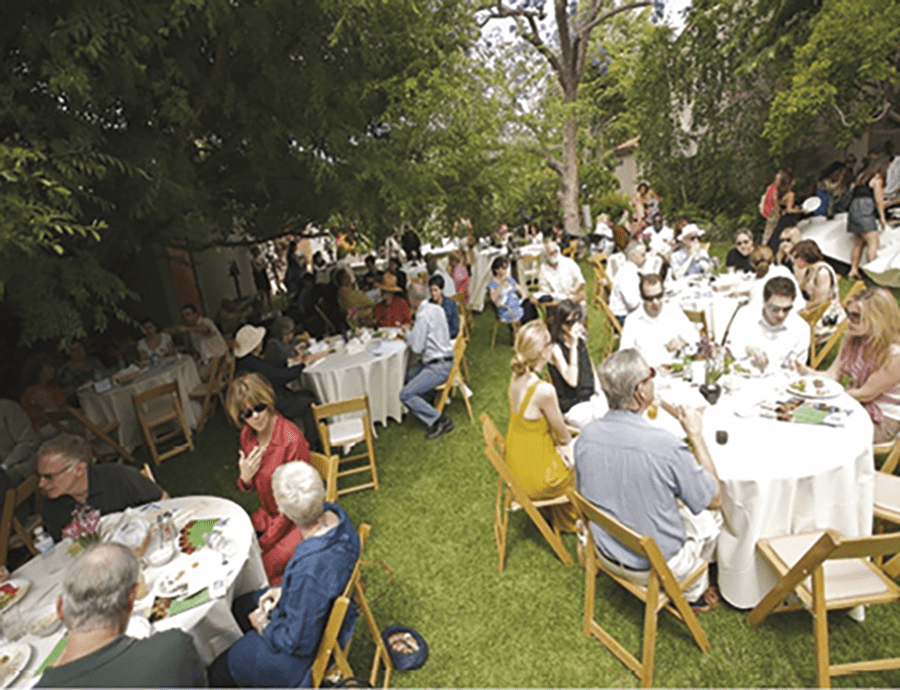
David Andersen enjoying the fruits of his labor
A cultural anthropology student at the University of Wyoming in the late 1960s, Andersen says he failed as a college student: "I have consistently failed upward throughout my life." After leaving school, he pursued a career as a musician playing in bands, but his life changed in a big way when he married and had a child. "I suddenly realized that if I continued playing music for a living, touring, being away at night, I would never see my family, wouldn't watch my daughter growing up."
In 1973, Andersen enrolled as a piano-technology student at a community college in Atlanta, Georgia. "I just resonated with my teacher. He told me I had a gift for this work, and that I was probably the most talented student he had ever taught." As Andersen's tuning skills developed, he made a living for several years tuning pianos at piano stores and for private clients in Atlanta and, later, Miami. "In 1980, I moved to Los Angeles because I was offered a record deal by an L.A. producer. He had heard one of my songs and felt that it would be a hit." After moving, Andersen completed the album. "It didn't sell," he says simply. "I knew I had to turn to my piano tuning in order to survive."
Andersen walked into the showroom of the local Steinway dealer. "Without anything to back it up, I told them that I was a great piano technician. They told me they had this new piano — right out of the crate — that needed to be completely prepped and tuned. I realized that I was seriously underprepared, so I went home and read everything I could lay my hands on about regulating and voicing, picked the brains of all my technician pals who were higher up the food chain than me, and went into the store and went to work on that piano. Somehow, I threw the net of illusion and scored a hefty gig. They started giving me clients. For the next half-dozen years, that store was 70% of my business."
When the Steinway dealership dramatically reduced its piano-prep hours in 1987, Andersen was forced to rely more on his private business. "I worked alone, and for a couple of years I didn't spend a lot of time with other technicians," he says. That changed abruptly in 1989, when Andersen had an experience he describes as "an epiphany." By this time, he recalls, "I had become a very good concert-prep technician, and an excellent tuner, regulator, and voicer. I'd prepared literally hundreds of Steinways of that era, and Asian instruments — all concert pianos. I'd just failed upward, and my on-the-job training had allowed me to become pretty sensitive and pretty diagnostically savvy. I'd had other technicians working under me at the warehouse, and had even gone to Korea a couple of times to try to get the quality control of some these instruments improved.
"But one day I put my hands on a piano that Richard Davenport had rebuilt and prepared, and it literally changed my life. I felt it was so exponentially better than a new piano. New soundboard, new action parts — it was orders of magnitude beyond what my fingers were used to. I thought, ‘I don't know anything! I need to get some education, I need to break this down, I need to get some help. I can't be a lone wolf anymore.' Within a short time, I took on an incredible apprentice. Stephen Bellieu was the apprentice everybody dreams about — the guy you trust with your childrens' lives in an emergency, but who was also a total piano geek, who already had a facility with tools, and spatial reasoning that was way beyond mine. He pulled me up and reinvigorated me in my own work."
During this time, Andersen had begun getting "some high-end gigs" with composers and performers. He also found himself doing new-piano prep work on many of the best European instruments, and his voicing skills rose to a new level. "I learned how to feel the needle in the felt, in my opinion the most important skill in voicing these high-compression hammers, and started to work at developing a real tonal memory." In the workshop, Andersen and Bellieu consulted with technicians such as Rick Baldassin, Bill Spurlock, Dale Erwin, and David Stanwood to find better and more efficient protocols for different aspects of piano restoration.

Showroom at Andersen's Atelier
In 1999, Andersen says, "I got out of a really bad marriage, and my life just blossomed. We started to do some really serious rebuilding. I started to attract a lot more attention in every realm. I started to dedicate more and more to being a piano technician. I just fully jumped in the river of ‘This is my life, this is my being, this is where the energy is, this is what I love to do.'
"I was always off and on trying to sell pianos — ‘gray-market' Yamahas and Kawais and a lot of Hamburg Steinways — in the 1980s, but I could never see myself sitting in a store someplace. That was a bleak prospect. So how could I still be a working technician, doing exactly what I wanted to do, but sell pianos I really loved and felt great about, to people I like — where there was some kind of pre-existing understanding of what kind of people would buy my pianos?"
About this time he read Thad Carhart's The Piano Shop on the Left Bank: Discovering a Forgotten Passion in a Paris Atelier, and a dream was born. "I started dreaming about a shop like the atelier in the book, where I could sell pianos I'd rebuilt, but more than that: a cooperative business that would let me work with people I truly admire and respect, each doing what they do best — a com-munity, a tribe, a team, based on character, based on love."<
Andersen's dreams suffered a setback in 2003, when he was diagnosed with rheumatoid arthritis. "The first weeks of rheumatoid arthritis were scary, because I didn't know what was going on. And in almost no time it went from normal to where I was basically crawling." Andersen has taken an active role in learning about and managing his RA, and is now able to lead a relatively normal life. During these first weeks of his illness, Andersen also met his life partner and fiancée, Tanya Ragir, an artist and sculptor.
Andersen and Bellieu concentrate on rebuilding piano actions in Andersen's workshop in Malibu. Using German-made action parts and incorporating the latest techniques for achieving a perfectly even and responsive touch, they also voice the hammers to bring out the full ranges of dynamics and color possible from each instrument. Andersen uses the talents of Modesto rebuilder Dale Erwin for rebuilding the piano's harp — the soundboard, bridges, pinblock, and strings — and refinisher Phenoyd Ezra of Van Nuys for restoration of the piano's case and cosmetics.

Concert at the Atelier
Once the pianos are fully restored, Andersen brings them to his own version of the atelier — the home he shares with Ragir in West L.A. There, in a converted garage, he shows his own rebuilt pianos alongside new pianos by the renowned German maker Steingraeber & Söhne. Explaining his low-pressure style of selling, Andersen says, "I wanted to have a place where I could basically change the traditional seller/buyer relationship. I say to them, ‘This is a love thing — it's about you falling in love with a piano. If you fall in love with one, we'll find a way for you to get it. If you don't, that's great. We have all the time you want to figure it out. So call me on my cell phone — I'll be in the house.' And I leave them. People love it."
From May to November, in the open-air courtyard between his house and the showroom, Andersen hosts monthly concerts featuring his pianos. "These concerts are all about the sound of the piano," he says. "The piano is always on the front edge of the stage. Around 80 or so chairs are right around the edge of the stage, and farther back are tables in Hollywood Bowl style."
Andersen pauses for a moment, reflects, then resumes. "I really love this world, this work, and I've surrendered to it. I love being challenged, and I love putting my hands on something that I conceived, directed, produced, and did even the final 10%. And to have someone look up from a piano I rebuilt and say, ‘This piano has everything I need' — how can you get a paycheck like that with money? It's what I call a reliable catalyst. Because the experience I'm after — which is the joy and fulfillment of giving something, helping somebody get some place — that experience produces joy inside me. It's not beamed into me by an artist, or a colleague, say, but the experience catalyzes something that's already inside of me. So being involved at a high level with pianos and piano human beings is one of the most reliable catalysts I've ever found. And my life is all about reliable catalysts.
"I should be in a wheelchair right now. Most people with this disease just sort of quietly disappear. Getting sick and really understanding that if I was going to get well, it was up to me — that was a wake-up call for me. It allowed me to see that you'd better do what you want to do, right now. You'd better have some kind of internal experience right now, because the time you think you have is an illusion. True fulfillment in this business is the kind of paycheck we talked about: helping another human being to catalyze joy, so in turn they can catalyze joy for other people." 
Visit David Andersen's website at www.davidandersenpianos.com.